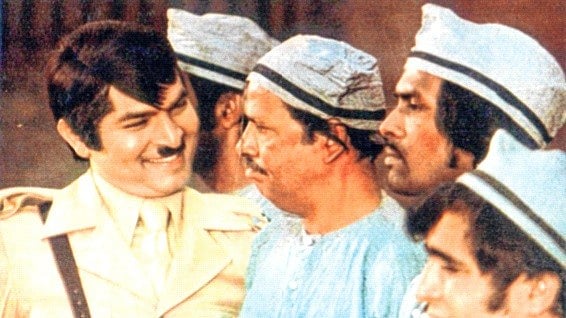Errrr…widow remarriage? Crowd feuding against anti-social elements? Male bonding? There was no dearth of relevance in Sholay. It was Salim-Javed’s take on Kurosawa’s Seven Samurai and also affiliated to Raj Khosla’s Mera Gaon Mera Desh.
A slick and unforgettable adaptation of Mehboob Khan’s Mother India and Nitin Bose’s Ganga Jumna, Deewaar also contained elements from Elia Kazan’s Hollywood classic On The Waterfront which was the source material for two major post-Deewaar productions—Mukul Anand’s Hum and Vikram Bhatt’s Ghulam.

A still from Deewaar |
The most wounded hero
Deewaar is the ultimate Angry Young Man saga. Full of soundless fury its protagonist’s anger is so inward-drawn you fear for his metabolism and blood pressure. Fists clenched, nerves on-edge and ever-itching for a fight with the scum of the earth, Vijay in Deewaar is the most wounded hero since Guru Dutt’s Vijay in Pyaasa.
Stylishly structured the film conveys tremendous emotional forces working to keep the drama on an even keel. Nirupa Roy in a role clearly modelled on Nargis in Mother India, is the mother torn between the ‘Good’ son Ravi(Shashi Kapoor) and the ‘Bad’ son Vijay(Amitabh Bachchan). The conflict of morality monitored by the mother-figure generates some of the best dramatic dialogue ever heard in a mainstream Hindi film including the now-legendary “Mere paas Maa hai’ uttered quietly by the Good Son Ravu when Vijay flaunts all his ill-gotten wealth in front of his brother and taunts him about his lack of material wealth.
As many as 50 years have passed since Sholay and its astonishing lines (Salim-Javed at their pithiest) created immediate and enduring history. Yes, the film opened badly. But then Rome and Amitabh Bachchan’s career weren’t built in a day. With each viewing of Sholay, I come away wiser and richer. Yes, this is what ‘Bollywood’ entertainment should always be but seldom is. Rich in drama, vivacious and vibrant in its characterisations, Sholay about one armless man’s two-men army and their battle against a sadistic dacoit (Amjad Khan) spawns innumerable eras of cinematic experience.
Most well assembled screenplay ever
With the passage of time, we can view the film in episodes: the stunning train robbery sequence at the start, the massacre of ‘Thakur’ Sanjeev Kumar’s family by Gabbar and his ragged henchmen, Dharmendra’s ‘suicide’ drama from atop a water tower, ‘Jai’ Amitabh Bachchan’s marriage proposal on behalf of his buddy ‘Veeru’ Dharmendra, ‘Gabbar’ Amjad Khan’s Russian roulette in the ravines with his trio of petrified henchmen, ‘Rahim Chacha’ A.K. Hangal’s son’s poignant death scene, the widow ‘Radha’ Jaya Bhaduri’s flashback into a colourful Holi when she accosts her future father-in-law with incessant chatter (Radha could have been Basanti), Jagdeep’s Soorma Bhopali and Asrani’s ‘angrezon ke zamaanein ka jailor’ episodes…. each of these and many others, have a throbbing autonomous life of their own.
And yet, here lies the magic of a monumental classic : all the accentuated episodes come together in a compelling cohesive screenplay which blows your mind.
This is a revenge story with a supremely sustained momentum. The characters show no sign of aging with time. Dharmendra and Amitabh Bachchan’s Veeru and Jai are to this day roguish mercenaries who seem to convey an endearing amorality in their conduct even as they emerge as unlikely heroes in the Thakur’s fight against an oppressively cartoonish outlaw. There are two romantic tracks navigated by two very contrasting female characters. While Basanti (Hema Malini) never stops chattering, Radha (Jaya Bhaduri) seldom speaks. They are portraits in contrasts done up in colours that have acquired deeper shades and relevance with the passage of time.
Dissertations, thesis, textbooks and essays have been written on the impact of Sholay on commercial Indian cinema. Does the narrative show any signs of wear and tear? Never! Except when meagre monetary amounts meant to be astronomical in 1975 are mentioned.
Javed Akhtar’s take
So which one is more meritorious and relevant?
Says Javed Akhtar, “It is impossible to say. If you are calling them(Sholay and Deewaar) classics—you are I am not—then it follows that they have both made an individual and lasting impact on the audiences’ psyche. Jahan tak relevance ka sawaal hai, har picture , har script ka apna relevance hota hai. You can’t compare Sholay with Deewar. They address two different situations.The crises they negotiated are not comparable.”
